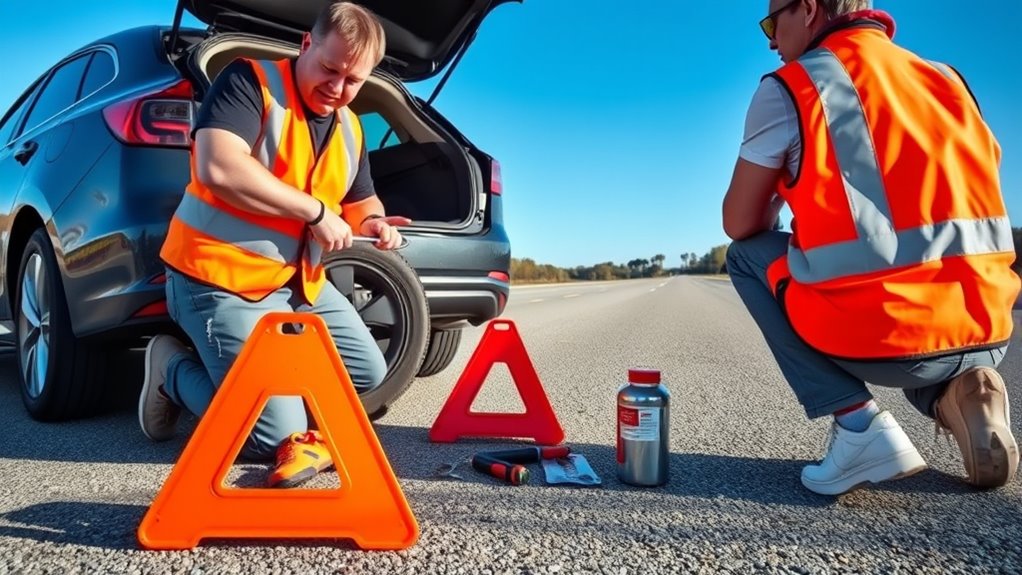To change a flat tire quickly and safely, first, find a safe spot away from traffic, turn on hazard lights, and gather your emergency kit. Loosen the lug nuts slightly, then use the jack to lift your vehicle at the recommended spot. Remove the flat tire and install the spare by hand-tightening the nuts in a crisscross pattern. Lower the vehicle and tighten the nuts fully. Keep your safety in mind and learn the full process to be prepared.
Key Takeaways
- Move to a safe, level location away from traffic and turn on hazard lights.
- Gather all emergency kit essentials, including gloves, before starting the tire change.
- Loosen lug nuts slightly before lifting the vehicle with a properly positioned jack.
- Raise the vehicle securely, remove the flat tire, then install and tighten the spare in a crisscross pattern.
- Lower the vehicle, double-check lug nut tightness, and store the flat tire safely for repair.

Have you ever been stranded on the side of the road with a flat tire? It’s a frustrating experience, but knowing how to change it quickly and safely can save you time and stress. Before you even get to that point, practicing proper tire maintenance is essential. Regularly checking your tire pressure, inspecting for damage, and ensuring your tires are in good condition can help prevent flats altogether. Keeping an emergency kit in your vehicle is equally important. Your kit should include a spare tire, a jack, a lug wrench, gloves, a flashlight, and reflective triangles or flares. These essentials prepare you for unexpected tire issues and help you handle them confidently.
When you notice a flat, first ensure you’re in a safe location away from traffic. Turn on your hazard lights to alert other drivers. Before starting to change the tire, gather your emergency kit essentials. Put on gloves if you have them; this keeps your hands clean and provides some protection. Loosen the lug nuts slightly while the tire is still on the ground—this makes removing them easier once the vehicle is lifted. Use the jack to lift your car, positioning it at the manufacturer-recommended spot, usually near the flat tire. Once the vehicle is raised, fully unscrew the lug nuts and remove the flat tire. Place the spare tire onto the hub, aligning the holes with the wheel studs. Then, hand-tighten the lug nuts in a crisscross pattern to secure the wheel.
Lower the vehicle slowly and then tighten the lug nuts firmly in the same crisscross pattern. Double-check each nut to ensure they’re tight, as loose lug nuts can cause the wheel to wobble or come off while driving. After replacing the tire, store the flat in your trunk or back seat, so you can have it repaired or replaced later. Remember, the key to safe tire changing is patience and caution. Avoid rushing, especially if the road is busy or conditions are unfavorable. Once the flat is replaced, take your vehicle for a quick drive to ensure everything feels secure. Proper tire maintenance and having your emergency kit essentials ready make these situations less intimidating, so you can handle them efficiently and get back on the road safely. Additionally, using a quality lug wrench ensures you can tighten nuts adequately without slipping.
Frequently Asked Questions
What Tools Should I Keep in My Car for a Flat Tire?
You should keep essential tools in your car for tire maintenance and emergencies, such as a spare tire, jack, lug wrench, and tire pressure gauge. An emergency kit with gloves, reflective triangles, and a flashlight is also crucial. These tools help you handle a flat tire efficiently and safely, ensuring you’re prepared for unexpected situations. Regularly check and maintain these items to stay ready on the road.
How Do I Prevent a Flat Tire From Happening?
You can prevent a flat tire by practicing regular tire maintenance, like checking tire pressure and tread depth, which helps you spot potential issues early. Be mindful of road hazards, such as potholes and debris, and avoid them whenever possible. Maintaining proper tire alignment and rotating your tires as recommended also reduces the risk of flats. Staying attentive to your tire condition and road conditions keeps you safer and minimizes flat tire chances.
Can I Change a Flat Tire on the Highway Safely?
Yes, you can change a flat tire on the highway safely if you follow proper highway safety protocols. Pull over to a safe spot, turn on your hazard lights, and keep a safe distance from traffic. If you’re uncomfortable or it’s too dangerous, roadside assistance is the best option. Always prioritize your safety and avoid attempting repairs in high-speed areas without proper precautions.
What Should I Do if I Don’T Have a Spare Tire?
Think of your flat tire as a roadblock in your journey. If you don’t have a spare, don’t panic; consider alternative solutions like calling roadside assistance or using a tire repair kit if available. These options act as your safety net, helping you get back on the road. Remember, professional help guarantees safety and saves time, so don’t hesitate to seek assistance when needed.
How Long Does It Typically Take to Change a Flat Tire?
Changing a flat tire typically takes about 15 to 30 minutes, depending on your experience and tools. You’ll spend the most time on flat tire removal and tire repair duration, like loosening lug nuts and securing the spare. Stay focused, work efficiently, and follow safety steps. With practice, you can reduce the flat tire removal time and get back on the road sooner.
Conclusion
Now you’re ready to tackle a flat tire confidently. Remember, staying calm and following the steps guarantees safety and efficiency. For example, imagine you’re on a road trip and suddenly get a flat; knowing exactly what to do means you can change the tire quickly and get back on the road. With practice, changing a flat becomes second nature. So, keep these tips in mind, and you’ll handle any flat tire with ease and confidence.









